Mezzanines
Mezzanines are elevated structures made from a variety of materials. These raised, often un-walled, platforms provide a solution to businesses with space limitations that cannot afford or do not wish to conduct building construction or expansion.
Note: An industrial mezzanine is not to be confused with a mezzanine card, which is a type of printed circuit board assembly.
Quick links to Mezzanines Information
Applications of Mezzanines
Mezzanines can store unused materials, provide a work platform for equipment, walking space for facility guests, and seat people in auditoriums (among many other uses). Mezzanines can also provide a floor space or a ceiling for offices. A small, in-plant office, for example, could be built beneath a mezzanine; in which case, the mezzanine floor could simultaneously provide the office ceiling and a platform for storage. Conversely, an office could be built above, at mezzanine level, allowing the space below to be used for storage or other uses.
Manufacturers, suppliers, distributors, and service companies all make use of mezzanines. These consumers include industries such as food service, storage, manufacturing, agriculture, aerospace, retail, education, transportation, healthcare, and outdoor recreation.
History of Mezzanines
The word “mezzanine” is a French word, which itself derived from the Italian “mezzanino,” a diminutive of “mezzano” meaning middle.
Mezzanine platforms have been around in one form or another for many years. Before the Industrial Revolution, they were most commonly used within theaters. When department stores emerged in the mid-1800s, mezzanines found a new application as store levels. After the Industrial Revolution, mezzanine types like the warehouse mezzanine and storage mezzanine became a staple of manufacturing.
Today, mezzanines are as relevant as ever, and even easier to make, as well as inexpensive and versatile.
Mezzanine Design Considerations
- Structural Design
- Base Plates
- The basic elements that you need to consider for the stability of a mezzanine are base plates. If you are new to mezzanines, you probably do not know that all mezzanines move and are not a rigid structure. However, the movement is only allowed to a certain degree. Typically, two types of movement occur in the elevated structure: lateral and deflection (which is the movement of the deck when one moves on it). Poorly structured mezzanines with inadequate base plates and offset base plates have considerable movement, therefore, the size and orientation of base plates become important. Base plates with 12 inches of length and breadth and three-fourth inches of width are recommended for standard mezzanines. Anchor bolts are as important as base plates because they provide adequate seismic connection.
- Columns
- What give support to horizontal, twisting, and vertical loads. While comparing quotes, you need to know the sizes of the columns, since it is common practice to cut the price by using undersized columns. Familiarize yourself with the sizes of all columns. A recommended standard column is a 5" x 3/16" tube, which gives support to varying loads.
- Braces and Other Hardware
- To add structural strength and reduce lateral movement, braces are often used. Cross and knee braces are used in fabricating lighter structures. If the columns are undersized, make sure braces supplement them. It is common among fabricators to cut costs by bolting the structure with low-quality nuts and bolts. High-grade bolts and nuts, such as A325, should be used.
- Material Design
- Typically, mezzanine structures are built using hot rolled steel, cold rolled steel, or stainless steel. Manufacturers may also use aluminum and fiberglass. However, they may do so only when building lighter structures that would not be exposed to heavy loads.
- Non-industrial mezzanines can be made with a number of materials, including wood. However, the place of wood plates is taken by composite lumber, which is used for making mezzanine floors and has proven to be a light and reliable solution. In industrial settings, mezzanines with wood flooring are used for storage. If used for other purposes, mezzanines need better structural strength than that which is offered by wood.
- Industrial mezzanines' load-bearing structures are usually made with steel elements and columns, which gives structural strength, and in some cases shelves or racks. Different materials are used in making the deck, including steel and aluminum plates, fiberglass, and particle boards.
- Steel plates are used when the deck has to withstand high loads; however, steel is heavy and expensive, which means that construction costs escalate when using steel plates. When decks are expected to hold lighter loads, aluminum plates are used instead of steel plates, since aluminum plates are lighter and easier to maintain than steel. When the deck will be utilized in a corrosive environment, fiberglass is used.
- The most widely used material for making decks is particle board, which is made from bonding several boards together. Particle board is used when the working environment is dry and the decks will not have large point loads.
- Worker Safety
- Regardless of their use or configuration, an important consideration all manufacturers must take into account during mezzanine design is worker safety. Most mezzanine access stairs have tread and are marked with brightly colored or reflective tape to reduce slipping or stumbling risks and perimeter railings to help prevent falls.
- Customization
- There are many ways that you can have your mezzanine structure customized. For instance, mezzanines can be equipped with lift, conveyor, and/or pallet racksystems to make storage and retrieval tasks less complicated. You can also have them designed with any number of features, including stairs, a roof deck, or a railing.
Advantages of Mezzanines
There are many reasons to invest in one or more mezzanines. First, constructing a mezzanine effectively doubles the capacity of the area in which it is installed. If you require more space, instead of a single elevated platform, manufacturers can install three tiers or triple deck mezzanines. This would give your business enough space to carry out operations unhindered.
Second, they’re highly versatile. Mezzanines can give you storage space, office space, and even working space. The only requirement of the space in which they are installed is a high ceiling, which is found in most industrial facilities.
Finally, if you are looking for means to expand your working and storage areas without investing heavily in construction, then mezzanines are the thing for you. Mezzanines can be efficiently added to any warehouse or building with a high ceiling in a matter of days, as mezzanines are installed rather than constructed.
Mezzanines' features of modularity, versatility, and their many possible configurations make them an excellent solution to space management problems. In addition, since many mezzanine systems are highly modular, they can be, if necessary, disassembled, expanded, reduced, or relocated.
Used Mezzanines
Used Mezzanines may have some wear and tear from previous use, but used mezzanines are typically structurally sound and can be refurbished or modified to meet specific needs. Whether it's expanding storage capacity in a warehouse or creating additional office space, used mezzanines offer a practical and budget-friendly alternative for businesses seeking efficient space utilization. Here are the advantages and disadvantages of used mezzanines, and why you might want to consider getting a new mezzanine.
Advantages of Used Mezzanines:
- Cost Savings: One of the most significant advantages of used mezzanines the is cost savings they offer. Buying a used mezzanine can be significantly cheaper compared to purchasing a brand-new one. This makes it an attractive option for businesses operating on a tight budget or looking for cost-effective solutions to expand their space.
- Quick Installation: Used mezzanines are typically already assembled or partially disassembled, making their installation process faster and more efficient. This allows businesses to save time and minimize disruptions to their operations when compared to the construction of a new steel mezzanine.
- Versatility: Used mezzanines come in a variety of sizes and configurations, offering flexibility to meet specific space requirements. They can be easily modified or adapted to fit different layouts, allowing businesses to customize the mezzanine to their unique needs.
- Sustainability: Opting for a used steel mezzanine contributes to sustainable practices by giving a second life to a structure that would otherwise be discarded. It reduces waste and promotes a more circular economy by reusing existing resources.
Disadvantages of Used Mezzanines:
- Limited Availability: Finding the exact used mezzanine for sale that matches specific requirements may be challenging. The availability of used mezzanines for sale near you also depends on market conditions and the specific features desired. This limited availability can sometimes make it difficult to find a suitable used mezzanine in a timely manner.
- Wear and Tear: Used mezzanines have already been used, which means they may show signs of wear and tear. While most used warehouse mezzanines are structurally sound, some repairs or refurbishment may be required to ensure their safety and longevity. This additional work could add to the overall cost and time investment.
- Potential Incompatibility: If a used warehouse mezzanine is not precisely tailored to a business's space and requirements, it may result in compatibility issues. Modifications or adjustments may be needed to fit the mezzanine into the existing layout or to meet specific needs, which can add complexity and additional costs.
- Limited Warranty:Unlike new mezzanines, used mezzanines often come with limited or no warranty coverage. This means that if any issues arise after the purchase, the buyer may bear the full responsibility for repairs or replacements such as if the used mezzanine floor loses non-slip coating or wears out the non-slip metal fabrication.
When considering the advantages and disadvantages, you should carefully evaluate your specific needs, budget, future needs, and timeline before deciding whether to opt for the long search for a used mezzanine or simply invest in a new one.
Mezzanine Accessories
Examples of accessories you may want for your mezzanine include OSHA stairs, ADA-certified railings, public access railings, a bar gate, a bar joist, decking, and extra shelving.
Whether or not an accessory will be of interest to you depends entirely on your application. Figure out what’s best for you by discussing your specifications and requirements with your manufacturer.
Mezzanine Installation
Mezzanine installation changes based on need. For example, mezzanines can be installed as a semi-permanent platform, which is something that has its own load-bearing piers and does not add tension to the original structure. On the other hand, some variations can be installed using the original structure load-bearing points, to give itself support. If this is the case, the mezzanine will typically be installed to extend from the floor.
Mezzanines can be assembled on-site. However, prefab mezzanines are assembled at the factory, then installed once they arrive on-site.
Mezzanine Standards and Compliance
There are guidelines about how every element of mezzanines should be made since they can be a potential danger to workers. These guidelines are mainly put out by the Occupational Safety and Health Administration (OSHA). If you do not follow these guidelines, your workers will be at risk and you could face substantial fines.
Your mezzanine system must be built and maintained following the standards and regulations of not only OSHA but also the International Building Code (IBC) and the American Institute of Steel Construction (AISC). Depending on where your facility is located and the intended use of your mezzanine, your structure may be subject to regulations such as the Uniform Building Code and the Americans with Disabilities Act.
Points to Consider When Selecting a Mezzanine
To have a suitable and long-lasting mezzanine, you must consider a few different factors before making the final decision.
The first step is a thorough evaluation of the requirements and the space in which the mezzanine will be installed. You will need to answer the following: if the mezzanine will be used as storage space, office space, or as support for equipment, the height of your ceiling, where exactly the unit will be installed, if there is enough space in your facility, and whether you will need a single or multiple-story structure.
- If You Have Enough Space
- Prefabricated mezzanines are the best options. Because they are produced in high volumes, they are relatively inexpensive. Unlike custom structural mezzanines, modular designs are significantly different. They are available in standard modules, typically 10x10 ft. Two or three modules are installed based on your needs. In modular designs, framing, columns, and the deck surface are all prefabricated. Electrical conduit, railing, staircase, gates, and kick plates can be selected individually, and a contractor will be responsible for installing them in your facility. However, as they are pre-made, you cannot decide on columns and other important elements that define the performance of a mezzanine.
- If You Do Not Have Enough Space
- Then you need to have a custom-made mezzanine, in which the primary steps involve on-site field measurements and drawings. In custom-made mezzanines, you can decide every element of the mezzanine, from design to columns, to deck and railings, as well as many other factors. These decisions can be difficult to make.
- Your first step should be to determine the slab in the facility (if it could support a mezzanine or if special footings will be needed to supplement the base). If you are considering a mezzanine for heavy equipment, it is usually recommended to have concrete footing. However, if you will be using the mezzanine for storage and other purposes that would not put heavy loads on the floor, then base plates with added braces will work fine for you.
- After making these decisions, you can translate your research into a quality mezzanine system with the help of the right manufacturer. The right manufacturer is the manufacturer who can demonstrate that they will work with you from start to finish to bring you the best solution. You can find this manufacturer by checking out the ones we have listed near the top of this page. All of those with whom we partner are reputable, experienced, and hardworking.
Mezzanine Images and Illustrations
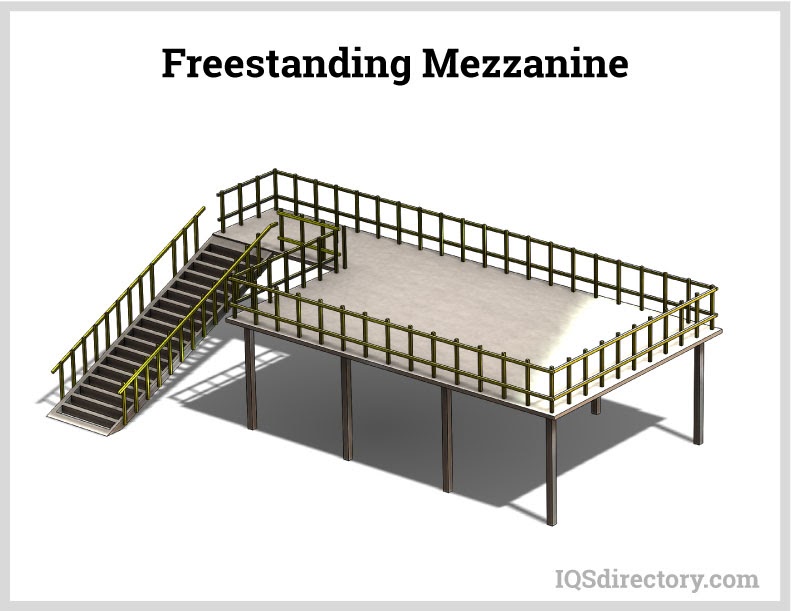 Free standing mezzanines are not connected to the main structure of the buildingand supported by columns bolted to the floor to take up the minimal amount of space as possible.
Free standing mezzanines are not connected to the main structure of the buildingand supported by columns bolted to the floor to take up the minimal amount of space as possible.
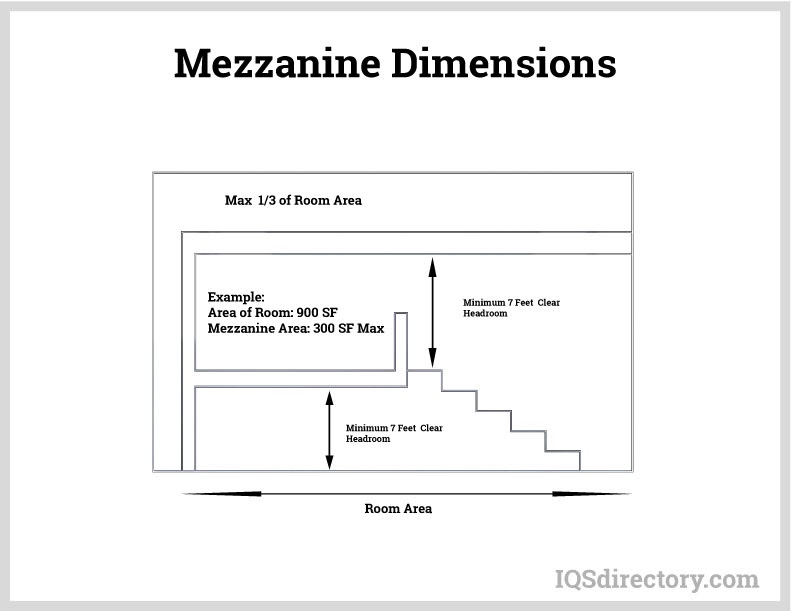 The clearance height above and below the mezzanine cannot be less than 7 feet, while the total area of a mezzanine cannot be greater than 1/3 the floor area of the location.
The clearance height above and below the mezzanine cannot be less than 7 feet, while the total area of a mezzanine cannot be greater than 1/3 the floor area of the location.
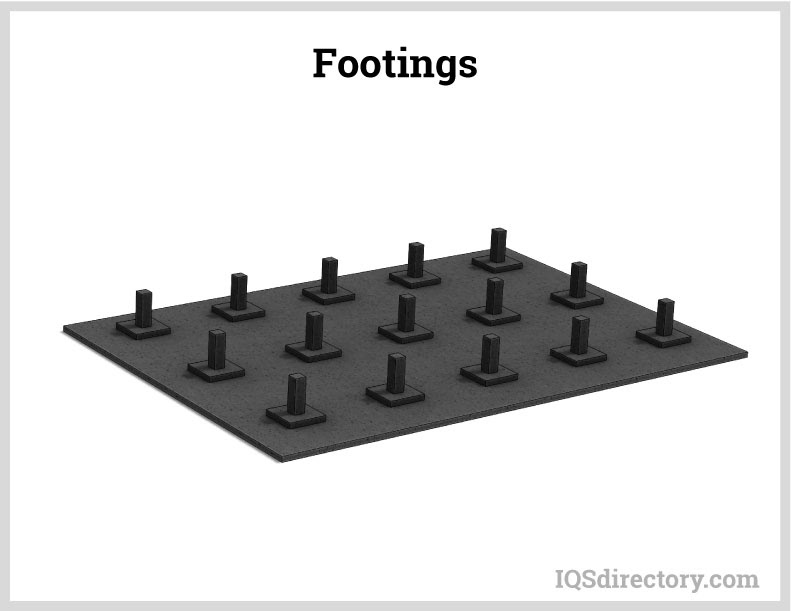 Necessary to determined that the building's concrete slab will not be able to handle the load.
Necessary to determined that the building's concrete slab will not be able to handle the load.
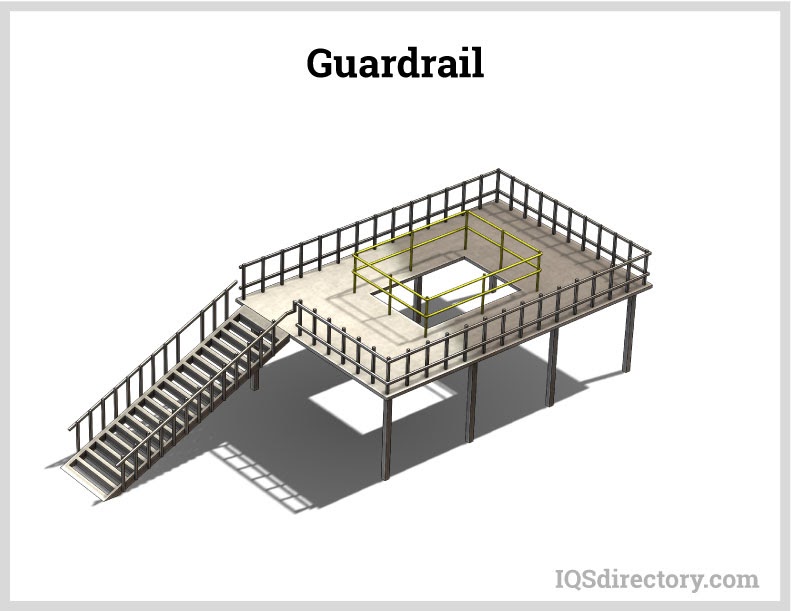 Mezzanines are required to have guardrail at a height of 42 inches.
Mezzanines are required to have guardrail at a height of 42 inches.
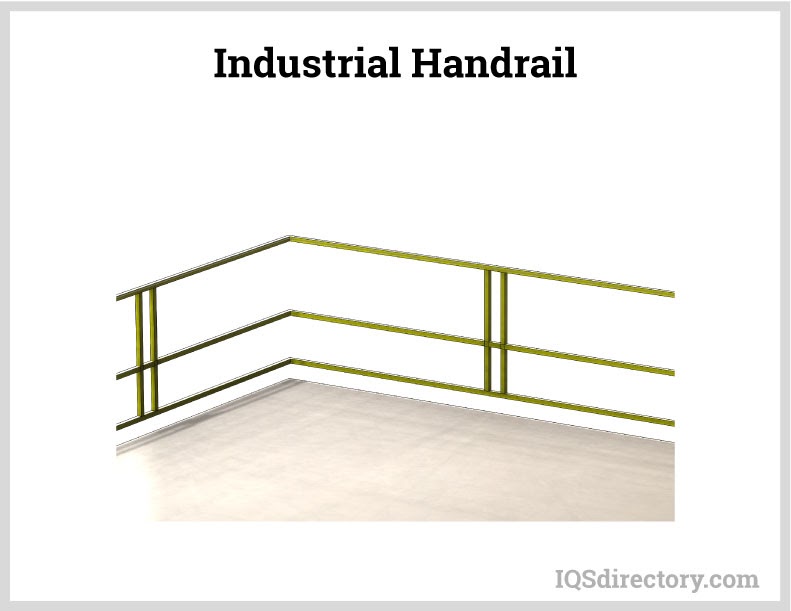 With exposed sides handrails are required must be welded, have a smooth, and have a continuous finish.
With exposed sides handrails are required must be welded, have a smooth, and have a continuous finish.
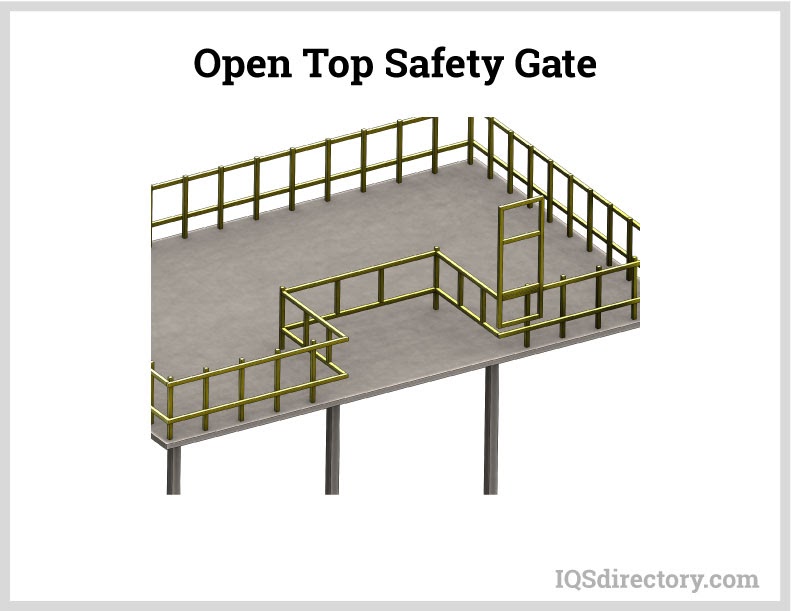 A gate set at a opening in guard rails to allow for better access to the top section of the mezzanine.
A gate set at a opening in guard rails to allow for better access to the top section of the mezzanine.
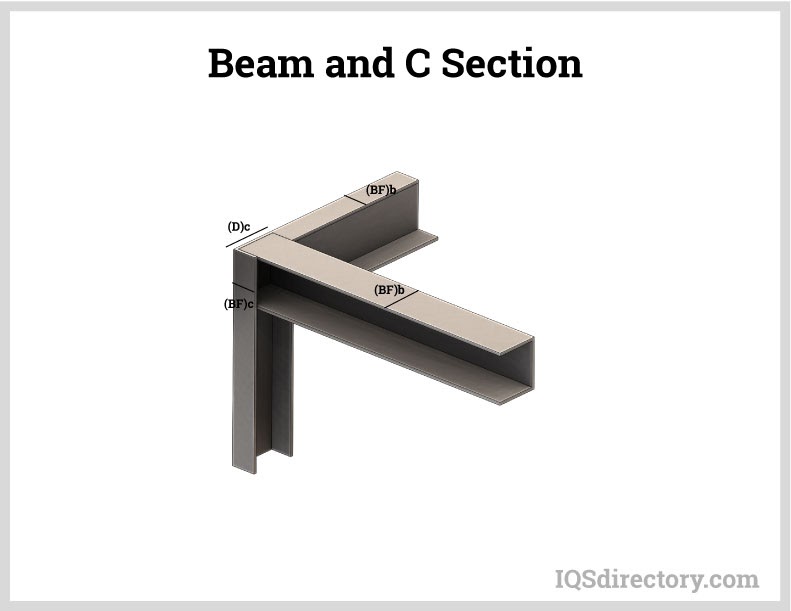 Beam and C-Section keeps the mezzanine to a minimum depth.
Beam and C-Section keeps the mezzanine to a minimum depth.
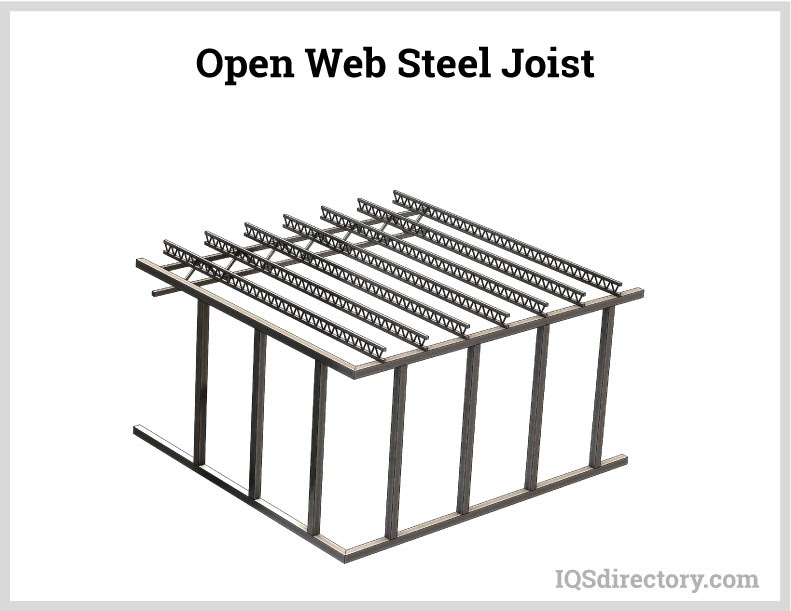 Bar Joist and Girder Joist are open-web supports floors or ceilings of a mezzanine to allow for higher capicity.
Bar Joist and Girder Joist are open-web supports floors or ceilings of a mezzanine to allow for higher capicity.
Mezzanine Types
- Aluminum Mezzanines
- A great choice for light-duty applications, as they are resistant to corrosion and easily washed. However, they cannot withstand heavy loads. The understructure of aluminum mezzanines is constructed from extruded aluminum, which is light as well as sturdy. For this purpose, aluminum is specially extruded in the form of I-Beams, C channels, and tubular columns. To complement the understructure, the deck is also made from light materials like aluminum grating and fiberglass.
- Cold Rolled Steel Mezzanines
- Constructed with sheet metal that is cold rolled, which is below the recrystallization temperature of steel by break press into a c-channel instead of an I-beam. They’re lighter, offer a significant cut on investment, and tend to be more aesthetically appealing than hot rolled steel mezzanines, which makes them suitable for public buildings. The columns used are either tubular or tapered. The handrail and gates are similar to hot rolled mezzanines.
- Custom Mezzanines
- Mezzanines configured to consumer specifications. Custom mezzanines consist of parts that are not “off the shelf” and often call for custom fabrication.
- Free Standing Mezzanines
- Raised platforms that can stand without leaning on, hanging from, or otherwise using the support of another structure. Free standing mezzanines, many of which are prefabricated, usually perform less demanding tasks, like the temporary storage of lighter-weight materials. Neither structural nor free standing mezzanines impede the operation of workers or machinery on lower levels. Their supports can be placed in a way that minimizes interference with the movement of personnel and equipment.
- Hot Rolled Structural Steel Mezzanines
- Have many elements. These include the understructure (made from open web bar joists) and structural I-beams and columns made from hot rolling (a milling process in which the steel is rolled at a temperature above the recrystallization temperature of steel). Additional elements like handrails can either be horizontal, baluster, or solid panel handrails. The gates of a structural steel mezzanine may be fabricated as lift out gates, swing gates, or sliding gates. They may have any kind of decking, including resin particle board, plywood, B deck, bar grating, plank, steel, and concrete.
- Structural Steel Mezzanines
- Offer greater column spacing, easy electrical conduit, water pipes, and more open space. However, they are heavier than other mezzanines and have rougher finishes. Also, they have a high floor and a dead load.
- Industrial Mezzanines
- Heavy-duty mezzanines designed to endure the heavier and shiftier loads industries are accustomed to dealing with.
- In-Plant Mezzanines
- Mezzanines constructed inside of a plant or building. An in-plant mezzanine is typically shipped unassembled and then put together once inside of the designated location.
- Metal Mezzanines
- Raised platforms that can be used in warehouses, factories, stores, in other industrial or commercial contexts for storage, or as office space.
- Mezzanine Construction
- The construction of structures within pre-existing buildings between the ceiling and the floor, essentially providing another story within the facility.
- Mezzanine Design
- The process of selecting building materials, schematics, and other elements of mezzanine construction before the installation of a mezzanine in a workspace.
- Mezzanine Floors
- Serve as the base for the entire upstairs area. They are placed over the supporting purlins. Common floorboard materials include plywood, diamond treaded steel, welding bar and metal plank gratings, various poly texture panels, and concrete.
- Mezzanine Manufacturers
- Produce structures that are intermediate floors between the main stories of a building.
- Mezzanine Systems
- All of the elements used to create an intermediate story to a building that sits between two main stories.
- Modular Mezzanines
- Mezzanines that are prefabricated in standard-size offerings. Modular mezzanines are usually limited to a lighter PSF capability, but they are shipped and installed quicker and generally cost less money.
- Office Mezzanines
- Raised platforms above or under which office space can be created.
- Perimeter Mezzanines
- Used in factories, warehouses, and other large buildings for the observation of floor operations and easy transportation from one end of a busy or full building to another. They can even be used to accommodate visitors or guests during tours. Perimeter mezzanines are an excellent choice when you need to store products for a short time.
- Prefabricated Mezzanines
- Mezzanine systems designed and partially assembled in a factory before full assembly by an end-user. They often come as a small, simple platform where supplies or products can be stored. However, in cases where a mezzanine will serve a more specialized purpose, manufacturers can create a custom mezzanine design. Such a design may include precise specifications like a specific floor perforation size, floor perforation shape, square footage, shelving design, or floor layout.
- Plant Mezzanines
- Transitional floors located in industrial plants.
- Stainless Steel Mezzanines
- A great choice in food service and the medical field, as they are resistant to moisture and chemicals with FDA-approved surfaces. They also look clean and appealing. Tubular stainless steel columns and I-beams are used for making the understructure for stainless steel mezzanines. Several materials are used when making decks, ranging from bar gratings to stainless diamond plates to planks. The structure does not need finishing products such as paints and primers, since these mezzanines are highly resistant to corrosive environments.
- Steel Mezzanines
- Semi-permanent steel structures that are built within pre-existing buildings between the ceiling and the floor.
- Storage Mezzanines
- Platforms used for the storage of products and equipment.
- Storage Platforms
- Semi-permanent stories built between the ceiling and floor of a building. They are designed to maximize usable storage space.
- Structural Mezzanines
- Use inherent members such as racks or shelving units to endure loads placed on the upper level. Structural mezzanines simply relocate the floor level area to the upstairs. They are platforms suspended by a combination of a building's own load-bearing elements and by columns and supports. They can be used to provide work surfaces for machinery and for the storage of heavy materials. Structural mezzanines are usually built into a building at the time of its construction. Their uses are usually predetermined and their design reflects their intended application.
- Warehouse Mezzanines
- Raised platforms used to create extra space in warehouses.
Mezzanine Terms
- Column Footing
- A support base for the mezzanine’s load-bearing columns. Column footings are often made of concrete or metal.
- Collateral Load
- Additional dead loads besides the structure’s weight and decking materials, such as sprinklers, ceilings, and electrical and mechanical systems.
- Dead Load
- The allowance in the load capacity of the mezzanine to account for the weight of the actual mezzanine structure.
- Equipment Platform
- Refers broadly to any elevated platform used in an industrial setting, such as manufacturing or material handling. Equipment platforms go by several different names, including mezzanines, steel structures, and process platforms.
- Grating
- An open grid of metal bars. Grid bars are attached to cross bars that run perpendicular to them or to bent connecting bars that extend between them.
- High Density Storage
- A storage method in which unitized loads are stocked more than one unit high and/or deep.
- Industrial Platform
- Raised platforms used to help workers complete tasks and function more efficiently within their space.
- Landing
- A platform at the end of stair flights. Landings are frequently used on mezzanines.
- Lateral Deflection (Drift)
- The amount a mezzanine will sway due to lateral loads.
- Lateral Load
- The force that acts horizontally on the mezzanine, causing it to sway. All mezzanine structures are designed to withstand a particular degree of lateral loading.
- Lift Truck
- Any vehicle used to lift, stack, rack, or move a load(s). Lift truck is synonymous with the term forklift.
- Live Load
- The maximum weight a mezzanine is designed to safely hold. Typical live loads range from 50 to 250 PSF.
- Metal Catwalks
- A type of flooring used frequently with mezzanine structures. Metal catwalks provide safe and efficient access to areas between spaces that could not otherwise be traversed.
- Office Platform
- Modular office spaces created using mezzanine platforms. Mezzanine platforms are raised floors supported by structural components, such as columns, beams, and fasteners.
- Observation Tower
- Tall structures designed to allow for the observation of landscapes or events from a long distance and with a 360° viewing range.
- Pounds Per Square Foot (PSF)
- A unit of measurement that signifies the number of pounds of pressure within a one square foot area.
- Purlin
- A structural member attached horizontally to the primary frames of mezzanines. Purlins provide support for the flooring and loads.
- Stair Tower
- Used to climb multi-level mezzanine structures. Stair towers are strong, stable, and will keep you and your employees from slipping or falling.